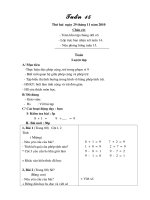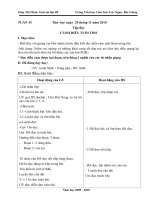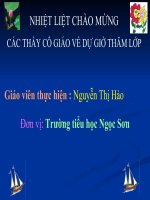Unit 15 lop 11day du
Bạn đang xem bản rút gọn của tài liệu. Xem và tải ngay bản đầy đủ của tài liệu tại đây (231.69 KB, 10 trang )
Teacher
Teacher: Dinh Tran Hoang Tuyen Vinh Trach High School - Lesson plan -
grade 11
Period:
Lesson 1: Reading
I.OBJECTIVES : By the end of the lesson, students will be able to:
- understand the space and astronauts, and know the way to talk about them
II. PREPARATION : Pictures, poster, handout, books…
III.PROCEDUCE:
Time
Contents T’s & Ss’ activities
5’
15’
8'
I/ Warm up:
1. Look at the picture and tell me what you see in picture 1
& 2.
2. What do you call a person who flies a plane/ spaceship?
3. Between them which job do you prefer? Why do you like
it?
Answer keys:
1. Picture 1: It's a plane
Picture 2: It's a spaceship
2. A person who flies a plane is called a pilot and a person
who flies a spaceship is called an astronaut.
3. I like pilot because I want to travel everywhere.
I like to be an astronaut because I want to the moon/ fly in
the space
T introduces the new lesson
II/ Before reading
- Look at the picture and match them with the descriptions
- T asks S to work in
groups to look at the
pictures and write down
what are in the pictures are
doing.
- Sts look at the picture and
write down what are in the
pictures are doing.
.
- T Gives some questions
- Sts give the answer
- T lead in the lesson
- T asks Ss to match the
UNIT 15
SPACE CONQUEST
Teacher
Teacher: Dinh Tran Hoang Tuyen Vinh Trach High School - Lesson plan -
grade 11
15’
2'
a. The first Vietnamese astronaut.
b. Yuri Alekseyevich Gagarin.
c. The orbit and a sattellite.
Keys:
Picture 1: b
Picture 2: c
Picture 3: a
Ask Ss to answer the questions
1- Who is the first human to fly into space?
2- Can you name the first human to set foot on the moon?
3- Who is the first Vietnamese fly into space?
Keys:1. The first human to fly into space is Yuri
Alekseyevich Gagarin.
2. The first human to set foot on the moon are Neil
Armstrong and Buzz Aldrin.
3. The first Vietnamese fly into space is Pham Tuan
Vocabulary:
T asks Sts the meaning and explains some new words
- lift off (v)
- cosmonaut (n)
- launch (v)
- precisely (adv)
- psychological (adj)
- deal with
- tension (n)
- venture (v)
- feat (n)
Have Ss read the new words in chorus
While-reading
Task 1: Match the heading to the paragraphs:
- T has Ss work in pairs to match the heading to the
paragraphs
Paragraph 1 A. The tragic accident
Paragraph 2 B. The lift - off
Paragraph 3 C. Congratulation
Paragraph 4 D. A view on Earth
Paragraph 5 E. Uncertainties
The answer:
Paragraph 1 B. The lift - off
Paragraph 2 E. Uncertainties
Paragraph 3 D. A view on Earth
Paragraph 4 C. Congratulation
pictures with the
descriptions.
- Ss work in pair
- Ss give the answers
- t corrects
- T asks some questions
and Ss answer.
- T corrects
- T pre- teach some new
words
Give the meaning
- leave the ground and rise
into the air
- an astronaut from the
former Soviet Union
- phong
- exactly
- thuoc tam ly
- solve a problem (doi pho,
giai quyet)
- cang thang
- lieu, mao hiem, ca gan
- ky cong
-Read in chorus
- T asks Ss to work in pairs
to match the heading to the
paragraphs
- Ss read the passage
individually and do task in
pairs.
- Ss give the answers
- T corrects mistakes
Teacher
Teacher: Dinh Tran Hoang Tuyen Vinh Trach High School - Lesson plan -
grade 11
Paragraph 5 A. The tragic accident
Task 2: Answer the question:
-Ask Ss to read the passage individually and do task 2 in
pairs
- Call on some Ss to write their on the board and the rest
play parts to ask and answer the questions
1. How old was Gagarin when he became the first human
being in space?
2. How long was he in space?
3. What questions were raised before Gagarin's space flight?
4. What was the speed of his spacecraft in orbit around the
Earth?
5. Why couldn't Gagarin make a new spaceship?
6. What was done after Gagarin's death to honour this
national hero?
Keys:
1. He was 27 then
2. He was in space for 108 minutes.
3. They were: "What would happen to a human being in
space or how the body would react to the extreme changes
in temperature and how the mind would deal with the
psychological tension?"
4. It was more than 17,000 miles per hour.
5. Because he died in a plane crash on a routine training
flight in March 1968.
6. After his death, his hometown of Gzahatsk was renamed
Gagarin, and the Cosmonaut Training Centre at Star City,
Russia, was given the name of this natioanal hero.
- Corrects and give comments
IV/ After you read
Complete the summary of the reading passage by putting
the words/ phrases in the box into blanks
- Asks Ss to work in groups to fill in the blank.
The answer:
1. cosmonaut 2. in space
3. lasted 4. success
5. gravity 6. view
7. impossible 8. named after
- Correct mistakes
Homework:
Ask Ss to learn new words and read the reading and
translate into Vietnamese
- Ss work in pair
- T asks Ss to read all the
questions and underline the
key words
- T calls some pairs to
practice before the class
- Then Ss write their
answers on the board
- T checks and gives
feedback
- Ss closing books
- T hangs poster on the
board and has Ss guess the
missing words
- Ss work in pairs
- T calls Ss and gives good
mark to encourage them.
- T corrects.
Work in groups to fill in
the blank Preparation:
List sth you like to do
Explain some new words
and translate the dialogue
into Vietnamese
Teacher
Teacher: Dinh Tran Hoang Tuyen Vinh Trach High School - Lesson plan -
grade 11
Preparation: Speaking
Period:
Lesson 2: Speaking
I.OBJECTIVES : By the end of the lesson, students will be able to:
-Know some astronauts and talk about them
-Talk about name, age and some important events of astronauts
II. PREPARATION : Pictures, poster, handout, books
III.PROCEDUCE:
Time
Contents Ts & Ss activities
5
12
I. Warm-up Matching
The answer:
Picture 1: He's Pham Tuan Vietnamese astronaut
Picture 2. He's Yuri Gagarin Russian cosmonaut
Picture 3: He's Amstrong American astronaut
Picture 4: He's Buzz Aldrin - American astronaut
Picture 5: He's Valentina Tereshkova - Russian cosmonaut
Picture 6: He's Liwei - Chinese astronaut
- Lead into the new lesson
What do you know about Apollo crew? First I am going to
help you know some new words.
II/ Pre - speaking:
Vocabulary:
- launch (v):phóng, ném
- spacecraft (n): tàu vũ trụ
- mark (v): đánh dấu
- milestone (n): mốc, bứơc ngoặc
- carry out (v): thực hiện, tiến hành
- artificial satellite : vệ tinh nhân tạo
- T asks Ss to close the
book and look at the
pictures and do the task.
- Ss do the task with their
partner
- T corrects mistakes
- T introduce the lesson
- T pre-teaches some new
words
- T asks Ss to read the
UNIT 15
SPACE CONQUEST
Teacher
Teacher: Dinh Tran Hoang Tuyen Vinh Trach High School - Lesson plan -
grade 11
17’
10’
- set foot on the moon: ®Æt ch©n lªn mÆt tr¨ng
Task 1: Read the following piece of news, then make
questions and answers
+ When……………………….?
+ What……………………… ?
+ How old……………………?
+ How important…………….?
+ How many………………… ?
A. When did China launch its first manned spacecraft into
space?
B. On October 15, 2003.
A. What is the name of China’s first manned spacecraft?
B. Its name is Shenzhou 5.
A. What is the name of the astronaut?
B. His name is Yang Liwei.
A. How old was he when he flew into space?
B. He was 38 years old.
A. How important was the successful flight to China?
B. The successful flight marked a milestone in China’s space
project.
A. How many countries in the world have been able to carry
out independently manned space activities? What are they?
B. There have been three. They are : Russia, The United State
and China.
III. While- speaking
Take turns to talk about the important events in space
exploration.
* Setting model.
+ Picture 1
A. When did Russia launch its first artificial satellite?
B. On October 4, 1957.
A. What is the name of Russia’s first artificial satellite?
B. Sputnik.
A. How important was the first artificial satellite To Russia?
B. The first artificial satellite marked the beginning of Space
Age.
+ Picture 4.
A. Who is the first woman to fly into space?
B. That is Valentina Tereshkova, a Russian cosmonaut.
A. When did she fly into space?
B. On June 16, 1963.
+ Picture 5.
A. Who are the first humans to set foot on the moon?
B. They are Neil Armstrong and Buzz Aldrin American
astronaut.
A. When did they set foot on the moon?
B. On July 20,1969.
passage in silence then find
out new words.
- T helps Ss deal with the
new words then explains
how to do the task.
- T can give Ss some
guiding words on the
board.
- Ss copy down their note-
book.
- T asks Ss to work in
groups then read aloud the
answers.
- Ss work in groups.
- T asks others to give
remarks.
- T corrects their mistakes
if necessary.
- T asks Ss to read task 2
carefully then find out new
words.
- Ss read in silence.
- T helps Ss deal with the
new words and explains
how to do the task.
- T can make models with
some students.
- T asks Ss to work in
groups.
- Ss listen to the teacher
then work in groups.
- T goes around and offers
help if necessary.
- After that the teacher can
ask Ss to work in pairs then
read aloud the dialogues.
- Ss work in pairs then read
aloud the dialogues.
Teacher
Teacher: Dinh Tran Hoang Tuyen Vinh Trach High School - Lesson plan -
grade 11
1’
IV. Post- Speaking
Task 3: Talking about the important events in space
exploration.
Work in groups to talk about the important events in space
exploration, using the given suggestions.
Modal:
On October, 1957 the first artificial satellite “ Sputnik”,
which was made by the USSR, was luanched into space. It
marked the beginning of Space Age.
Answers:
2. On 3
rd
November, 1957, a dog named Laika was the first
living thing being in space. It was abroad Sputnik 2.
3. On 12
th
April 1961, Yuri Gagarin, a 27 year-old Russian
cosmonaut, became the first human in space. His flight lasted
108 minutes.
4. On 16
th
June, 1963, Valentina Tereshkova, a Russian
cosmonaut, became the first woman in space.
5. On 20
th
July, 1969, two American astronauts, Neil
Amstrong and Buzz Aldrin, were the first people to set foot
on the moon.
6. On 23
rd
July 1980, Pham Tuan became the first
Vietnamese in space. Along with V. V Gorbotko, a Russian
cosmonaut, he stayed 8 days in orbit.
7. On 29
th
October, 1998, John Glenn, an American astronaut
was the oldest human ever to fly into space at the age of 77.
8. On 15
th
October 2003, Yang Liwei, 38 years old, becme
the first Chinese to spend 21 hours in space.
V. Homework: Write a short paragraph about the one
important event in space conquest
Preparation: listening
Ask Ss:
- Explain some new words in before listening
- Find meaning of the Task 1 and 2
- T divides the class into
small groups and each
group talk about two
events.
- T has Ss study the
information carefully and
reminds them to use the
correct verb tense as well
as use passive voice when
necessary.
- T goes around the class to
check and offer help.
- T calls on some Ss to talk
in front of the class.
- T elicits feedback and
give final comments.
Teacher
Teacher: Dinh Tran Hoang Tuyen Vinh Trach High School - Lesson plan -
grade 11
Period:
Lesson 3: Listening
I.OBJECTIVES : By the end of the lesson, students will be able to:
- Listen to the first event that men set foot on the moon
II. PREPARATION : Pictures, poster, handout, books…
III.PROCEDUCE:
Time Contents T’s & Ss’ activities
5’
10’
10'
I. Warm-up
Matching cards with the pictures (page 172)
Pictures Cards
-Picture 1 Orbiting
- Picture 2 The Apollo crew
- Picture 3 Walking on the moon
- Picture 4 The Moon landing
- Picture 5 The first foot print on the Moon
Introduce the new lesson
Question:” From the pictures can you guess what topic we are
listening today?”
New lesson: LISTENING
II. Pre- listening
Vocabulary:
- surface (drawing)
T draws the surface of the road, and elicits the word “surface”
- experiment (n) (question)
What do scientists often do in laboratories?
Expected answer: experiment
- astronaut (n) ~ spaceman
- challenge (n) (translation)
Listen and repeat: Say STOP if you hear one of these words
from the listening passage
Congress challenge NASA Kennedy
Mission experiment Michael Collins Apollo
Reminder achievement Neil Armstrong Buzz Aldrin
III. While-speaking
Task 1:
As I have said, this time you are gong to listen about the Apollo
- T divides the class into 4
groups
- Ss representative of each
group write the answer on
the board
- Group which gives the
correct answers quickly
will be the winner
- T leads to new lesson:
- T pre-teaches somw new
words
- T has Ss open the book
and look at the words
carefully
- T plays the recorder and
Ss say STOP
- T stops the recorder to
check
- T gives Ss handouts of T-
UNIT 15
SPACE CONQUEST
Teacher
Teacher: Dinh Tran Hoang Tuyen Vinh Trach High School - Lesson plan -
grade 11
10'
10’
crew, who first reached the moon. Listen and work in pairs to
decide if the statements are true or false.
Remember that the tape will be played twice.
1. In a speech to the press, US President Kennedy asked the
nation to put a man on the moon.
2. There were 11 astronauts on board the spacecraft to the moon.
3. The astronauts landed on the moon's surface at the same time.
4. To walk on the moon, the astronauts had to carry a suitcase
with oxygen in it.
5. An American flag was placed on the moon's surface after the
moon landing.
Keys:
1. F (in a speech to the congress)
2. F (Three)
3. F (They landed at different time)
4. F (They had carry a suitcase with a portable life support
system)
5. T
Task 2: Answer the questions by circling the letter A, B, C or D
1. Which program was developed to meet president Kennedy ‘s
challenge?
A. NASA’s Apollo program B. ASIAN
C. NATO D. VOA
2. When was the Apollo 11 launched?
A. July 16, 1969 B. July 16, 1996
C. June 16, 1996 C. June 16, 1969
3. What was the portable life support system for?
A. Controlling the Oxygen B. Temperature
C. Temperature and pressure
D. Controlling the oxygen, temperature and pressure
4. How long did the astronauts stay on the surface of the moon?
A. two and a half hours B. Half an hour
C. an hour D. three and a half hours.
5. What did they do while they were staying on the surface of
the moon?
A. Collect soils and rock samples
B. Collect soil and perform experiments
C. Perform the variety of experiments and collect soil
D. Perform the variety of experiments, collect soil and rock
samples to return the Earth
6. When did the astronauts return to the Earth?
A. July 24, 1968 B. July 24, 1969
C. June 24, 1996 D. June 24, 1969
Keys:
1.A 2.A 3.D
4.A 5.D 6.B
IV. Post- listening
Discuss the reason for the human interest in Mars and other
F test
- T plays the tape twice.
- Ss work alone and then
share their answers with
their partner
- T calls on some Ss to give
their answers
- T corrects with the whole
class
- T gives handouts to Ss
then explains some difficult
if necessary
- Ss listen and choose the
answer. Then share their
answers with their partner
- T calls Ss to answer and
plays recorder again to
feedback
Teacher
Teacher: Dinh Tran Hoang Tuyen Vinh Trach High School - Lesson plan -
grade 11
planets in the solar system.
Fill in the blanks with the missing words
There are many reasons for human interest in Mars and other
planets in the solar system. Firstly, Man likes (1)………….and
wants to find out (2)………outside the World. One day, we may
(3) ………people to Mars and other planets in case the Earth is
overpopulated. We may also conduct (4) …………on Mars and
other planets for the (5)……… of people on Earth. We may
find (6)…………minerals there and have trips to other planets
for tourist purposes
Keys:
(1) adventure (2) Possibilities of life
(3) send (4) researches
(5) benefits (6) precious
V. Homework
. Write a paragraph In your opinion, What is the reason for
human interest in mars and other planets in the solar system?
Keys: I think – they want to find out possibilities of life outside
the earth
They may find some precious things there.
They have trips to another plants for tourist purposes
Prepare the writing
- Using handouts
- Ss work in groups of four.
- T explains some difficult
words if necessary
- T reads the passage
- Ss listen and do the task
- T calls some group and
checks. If any group gives
many correct words, T can
gives good marks
Tapescript
In a speech to the Congress in 1961, the US President Kennedy challenged the nation to
put a man in the moon before the end of the decade. After the president’s speech, NASA’s
Apollo program was developed to meet the challenge.
On July 16, 1969, the Apollo 11 was launched. The astronauts on board of the
spacecraft were Neil Armstrong, Buzz Aldrin and Michael Collins.
On July 20, 1969, Neil Armstrong became the first man on the moon. He was followed
by Aldrin 40 minutes later. TO walk on the moon surface, the astronauts need to wear a
spacesuit with a portable life support system. This controlled the oxygen, temperature and
pressure inside the spacesuit.
Armstrong and Aldrin spent a total of two and a half hours on the moon’s surface. They
performed a variety of experiments and collected soil and rock samples to return to the Earth.
An American flag was left on the moon’s surface as a reminder of the achievement.
The crew of Apollo 11 returned to the Earth on July 24, 1969. They successfully
completed their historic mission. It is regarded as the greatest human efforts in the history of
man kind.
Checking:
T asks Ss to complete the following sentences with the words just learnt.
a. They couldn’t walk on the moon’s……….unless they wore spacesuit.
b. Putting a man on the moon was a great……….at that time.
c. Mr. Minh is doing his……….in the chemistry laboratory.
d. He was the first……….to reach the moon
Teacher
Teacher: Dinh Tran Hoang Tuyen Vinh Trach High School - Lesson plan -
grade 11









